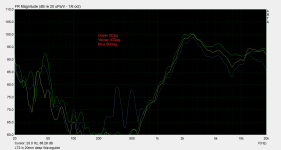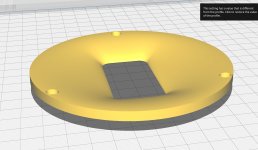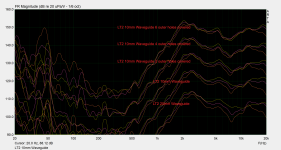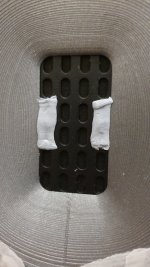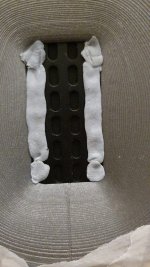Just thought I'd share these.
IMO this is a nice tweeter in terms of distortion, but response is a bit bumpy. This is in a flat face plate (3mm thick), not the waveguide they sell. 18cm x 28cm baffle, so that is causing diffraction around 4KHz.

At the price I'd choose it over a Neo3 clone though, especially as the pair I got have better matching. I may use it as a supertweeter. Creases / folds in the diaphragm are pretty 🙂
Interesting to note the stiff felt bars on the outer edges of the front plate are not present on the back (can see through the diaphragm). The B&G Neo3 PDR also has bars like this but plastic. Missing on the clones I've seen (Sounderlink and GRS). I think they help reduce the diffraction blip in the top octave.
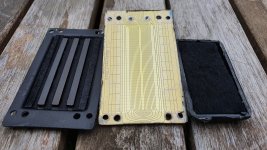
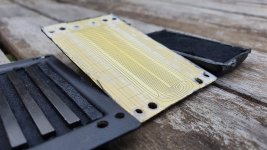
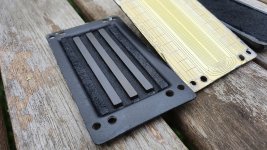
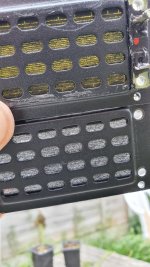
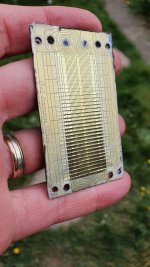
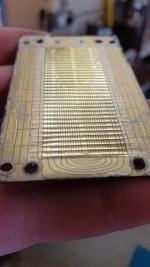
IMO this is a nice tweeter in terms of distortion, but response is a bit bumpy. This is in a flat face plate (3mm thick), not the waveguide they sell. 18cm x 28cm baffle, so that is causing diffraction around 4KHz.
At the price I'd choose it over a Neo3 clone though, especially as the pair I got have better matching. I may use it as a supertweeter. Creases / folds in the diaphragm are pretty 🙂
Interesting to note the stiff felt bars on the outer edges of the front plate are not present on the back (can see through the diaphragm). The B&G Neo3 PDR also has bars like this but plastic. Missing on the clones I've seen (Sounderlink and GRS). I think they help reduce the diffraction blip in the top octave.






Attachments
Last edited:
10mm waveguide gives an on-axis that is less smooth than the 20mm waveguide, but on the other hand it tracks better with the off-axis around the 13KHz region.
I also tried covering up some of the outer holes, which helped make the on and off-axis track better again. This means it is more EQ'able and dispersion is more even, although the over-all response might be less manageable in a passive system. Better for a DSP system. Each data set is scaled by 10dB, so you will also note covering holes reduces output slightly.
I also tried covering up some of the outer holes, which helped make the on and off-axis track better again. This means it is more EQ'able and dispersion is more even, although the over-all response might be less manageable in a passive system. Better for a DSP system. Each data set is scaled by 10dB, so you will also note covering holes reduces output slightly.
Attachments
Another option for the outer holes may be to put thin felt on them, as you essentially referenced earlier. The GRS PT2522-4 does have that feature.
Instead of helping with diffraction, I think the thin low-density felt on the GRS is more about restricting the apparent width of the radiating element at higher frequencies, while allowing the lower frequencies to pass mostly unimpeded. This prevents some of the beaming/irregular polar response that normally happen when driver width is greater than about 1/3 wavelength.
1/8" F13 felt is the one I normally use for stuff like this.
Instead of helping with diffraction, I think the thin low-density felt on the GRS is more about restricting the apparent width of the radiating element at higher frequencies, while allowing the lower frequencies to pass mostly unimpeded. This prevents some of the beaming/irregular polar response that normally happen when driver width is greater than about 1/3 wavelength.
1/8" F13 felt is the one I normally use for stuff like this.
Last edited:
Thanks for the reply. I did try felt on the outside as well, but it tended to only widen the dispersion while keeping the same over-all frequency response.
That said, adding or removing the felt inside a Neo3 PDR where it is between the magnets makes a big difference to these type of peaks. I suppose this is because it is damping the location where the problem is occurring, rather than just covering over the front once the problem has already occurred.
That said, adding or removing the felt inside a Neo3 PDR where it is between the magnets makes a big difference to these type of peaks. I suppose this is because it is damping the location where the problem is occurring, rather than just covering over the front once the problem has already occurred.
Thank you for doing this 🙂 always interesting to take a look. 120 micron thick foil... jees 🙂 thats quite allot. they are using some thick kapton.
i mean alu is between 15-30mic. thats leaves 90 +- for adhesive and alu foil.
i mean alu is between 15-30mic. thats leaves 90 +- for adhesive and alu foil.
Anybody know how to remove the magnets from the metal plat without breaking them?
Edit: NVM hot air at 100C on the metal plate side, magnets pulled off. Magnet never got that hot, I could still hold in my hand.
Edit: NVM hot air at 100C on the metal plate side, magnets pulled off. Magnet never got that hot, I could still hold in my hand.
Last edited:
Great jobJust thought I'd share these.
IMO this is a nice tweeter in terms of distortion, but response is a bit bumpy. This is in a flat face plate (3mm thick), not the waveguide they sell. 18cm x 28cm baffle, so that is causing diffraction around 4KHz.
View attachment 1048991
At the price I'd choose it over a Neo3 clone though, especially as the pair I got have better matching. I may use it as a supertweeter. Creases / folds in the diaphragm are pretty 🙂
Interesting to note the stiff felt bars on the outer edges of the front plate are not present on the back (can see through the diaphragm). The B&G Neo3 PDR also has bars like this but plastic. Missing on the clones I've seen (Sounderlink and GRS). I think they help reduce the diffraction blip in the top octave.
View attachment 1048981View attachment 1048982View attachment 1048983View attachment 1048984View attachment 1048985View attachment 1048986
- Home
- Loudspeakers
- Planars & Exotics
- Radian LT2 Planar Teardown Photos
